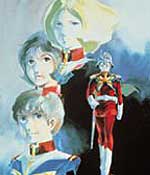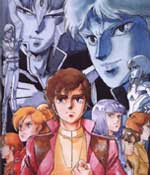|
Also groundbreaking were the heroes and villains of the show. The protagonist, young Amuro Ray, was a reluctant warrior - a far cry from the eager-beaver heroes of the anime shows which preceded it. His angst, mild as it was, echoes down the years to contemporary mecha shows to such an extent that the pacifist nature of "Dual's" Kazuki Yotsuga seems more a clich� than anything else.
And the villain of the piece...ah, you can't have a first-rate space opera without a memorable villain to relish, and handsome Char Aznable fit the bill perfectly. A tragic and sympathetic character bent on avenging his father by plotting the downfall of the Zabi family, Aznable fights to gain the trust of those he means to kill. The Red Comet, as he is known to friend and foe alike, was a more complex character than the scenery-chewing bad guys viewers were accustomed to seeing. While American cartoons continued to crank out villains like Skeletor - who opposed the protagonists because "being evil is so much fun and I want to rule the world, ha-ha-ha" - anime antagonists in the aftermath of "Gundam" began to develop depth and more compelling motivations. The supporting characters were no less developed. Moral ambiguity was the word of the day. There are unpleasant and amoral people fighting right alongside our heroes, and honorable men and women enlisted on the enemy side. This blending of white and black was particularly pronounced in 1985's sequel "Zeta Gundam," which featured the Titans, a new and overzealous Earth Federation faction willing to wipe out civilian populations to stamp out the Zeon menace. Assured that "Mobile Suit Gundam" was a certifiable hit, Sunrise brought back the original animation team for "Zeta Gundam." The writers, rejecting the temptation to retread prior adventures and rest on their laurels, introduced new characters and realigned all the political factions for new conflicts. Zeta, though in many ways a dark study in the evils of human nature, was a huge hit, and proved once and for all that the "Gundam" phenomenon could not only be repeated, but could be narratively progressive as well.
Perhaps in need of a break from all that grimness, Sunrise did a bootlegger's reverse with 1986's "Gundam ZZ" (read
"Gundam Double Zeta"), shifting from atrocities and melodrama to wacky fun with a new kiddy cast, beating "Phantom
Menace" to the punch by 15 years. "Gundam ZZ" was a crowd-pleaser, but a disappointment to many fans. 1988 saw the
first "Gundam" movie, "Char's Counterattack," which closed out the original setting (for the moment) by resolving both
the Earth Federation/Zeon conflict and the Ray/Aznable rivalry. Catch Part Two of "The Gundam Phenomenon" on Akadot this Friday, July 13, and part three on Monday, July 16. Note: The author would like to thank Jerry Chu of Bandai Entertainment, as well as Mark Simmons (and his Gundam Project website www.gundamproject.com), both of whom proved to be invaluable resources in confirming dates and details. |
||||||||
|
Mobile Suit Gundam © Sotsu Agency / Sunrise.
Mobile Suit Gundam - Gundam ZZ © Sotsu Agency / Sunrise.
|


